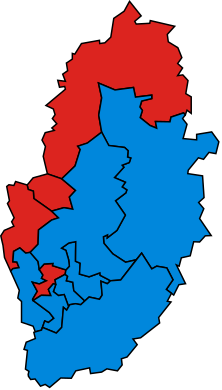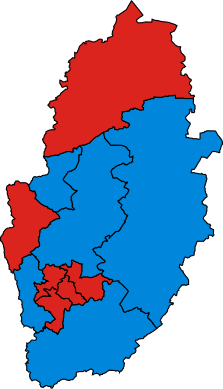Parliamentary constituencies in Nottinghamshire
From Wikipedia, the free encyclopedia
The ceremonial county of Nottinghamshire, (which includes the unitary authority of Nottingham), is divided into 11 parliamentary constituencies - three borough constituencies and eight county constituencies.

Constituencies
† Conservative ‡ Labour ¤ Reform UK
| Constituency[nb 1] | Electorate[1] | Majority[2][nb 2] | Member of Parliament[2] | Nearest opposition[2] | Map | ||
|---|---|---|---|---|---|---|---|
| Ashfield CC | 68,095 | 5,509 | Lee Anderson¤ | Rhea Keehn‡ |  | ||
| Bassetlaw CC | 78,161 | 5,768 | Jo White‡ | Brendan Clarke-Smith† |  | ||
| Broxtowe CC | 70,440 | 8,403 | Juliet Campbell‡ | Darren Henry† |  | ||
| Gedling CC | 75,795 | 11,881 | Michael Payne‡ | Tom Randall† |  | ||
| Mansfield CC | 74,535 | 3,485 | Steve Yemm‡ | Ben Bradley† |  | ||
| Newark CC | 79,783 | 3,572 | Robert Jenrick† | Saj Ahmad‡ |  | ||
| Nottingham East BC | 69,395 | 15,162 | Nadia Whittome‡ | Rosey Palmer (Green) |
 | ||
| Nottingham North and Kimberley BC | 73,768 | 9,427 | Alex Norris‡ | Golam Kadiri¤ |  | ||
| Nottingham South BC | 64,255 | 10,294 | Lilian Greenwood‡ | Zarmeena Quraishi† |  | ||
| Rushcliffe CC | 79,160 | 7,426 | James Naish‡ | Ruth Edwards† |  | ||
| Sherwood Forest CC | 76,543 | 5,443 | Michelle Welsh‡ | Mark Spencer† |  | ||
Boundary changes
Summarize
Perspective
2024
See 2023 Periodic Review of Westminster constituencies for further details.
For the 2023 Periodic Review of Westminster constituencies, which redrew the constituency map ahead of the 2024 United Kingdom general election, the Boundary Commission for England opted to retain the eleven constituencies in Nottinghamshire, as detailed below, with minor boundary changes to reflect changes to electoral wards within the county and to bring the electorates within the statutory range. As Nottingham North now contains wards in the Borough of Broxtowe, it was renamed Nottingham North and Kimberley. Sherwood was renamed Sherwood Forest.[3][4] These changes came into effect for the 2024 general election.
The following constituencies were proposed:
Containing electoral wards in Ashfield
- Ashfield (part)
- Sherwood Forest (part)
Containing electoral wards in Bassetlaw
Containing electoral wards in Broxtowe
Containing electoral wards in Gedling
- Gedling
- Sherwood Forest (part)
Containing electoral wards in Mansfield
- Ashfield (part)
- Mansfield
Containing electoral wards in Newark and Sherwood
- Newark (part)
- Sherwood Forest (part)
Containing electoral wards in Nottingham
- Nottingham East
- Nottingham North and Kimberley (part)
- Nottingham South
Containing electoral wards in Rushcliffe
- Newark (part)
- Rushcliffe
2010
In the Fifth Review the Boundary Commission for England recommended that Nottinghamshire retained its current constituencies, with changes only to reflect revisions to local authority ward boundaries and to reduce the electoral disparity between constituencies..
Results history
Summarize
Perspective
Primary data source: House of Commons research briefing - General election results from 1918 to 2019[5]
2024
The number of votes cast for each political party who fielded candidates in constituencies comprising Nottinghamshire in the 2019 general election were as follows:[2]
| Party | Votes | % | Change from 2019 | Seats | Change from 2019 |
|---|---|---|---|---|---|
| Labour | 201,997 | 41.5% | 9 | ||
| Conservative | 119,325 | 24.5% | 1 | ||
| Reform | 94,331 | 19.4% | 1 | ||
| Green | 30,517 | 6.3% | 0 | ||
| Liberal Democrat | 22,827 | 4.7% | 0 | ||
| Workers | 4,459 | 0.9% | New | 0 | |
| Others | 13,060 | 2.7% | 0 | ||
| Total | 486,516 | 100.0 | 11 |
Percentage votes
| Election year | 1974
(Feb) |
1974
(Oct) |
1979 | 1983 | 1987 | 1992 | 1997 | 2001 | 2005 | 2010 | 2015 | 2017 | 2019 | 2024 |
|---|---|---|---|---|---|---|---|---|---|---|---|---|---|---|
| Labour | 46.9 | 47.3 | 42.8 | 32.2 | 34.7 | 44.4 | 54.3 | 50.9 | 44.5 | 37.0 | 39.7 | 48.0 | 37.4 | 41.5 |
| Conservative | 39.6 | 35.6 | 45.0 | 45.1 | 46.0 | 42.7 | 30.5 | 34.0 | 33.1 | 35.9 | 36.7 | 43.9 | 47.4 | 24.5 |
| Reform1 | - | - | - | - | - | - | - | - | - | - | - | - | 2.9 | 19.4 |
| Green Party | - | - | - | - | * | * | * | * | * | 0.6 | 3.7 | 1.0 | 1.9 | 6.3 |
| Liberal Democrat2 | 13.0 | 16.3 | 11.5 | 21.9 | 18.6 | 12.1 | 10.9 | 13.1 | 16.2 | 19.2 | 4.7 | 2.9 | 6.2 | 4.7 |
| UKIP | - | - | - | - | - | - | * | * | * | 3.4 | 14.9 | 2.9 | * | - |
| Other | 0.5 | 0.8 | 0.8 | 0.7 | 0.6 | 0.7 | 4.3 | 2.0 | 6.3 | 3.8 | 0.4 | 1.2 | 4.3 | 3.6 |
1As the Brexit Party in 2019
21974 & 1979 - Liberal Party; 1983 & 1987 - SDP-Liberal Alliance
* Included in Other
Seats
| Election year | 1974
(Feb) |
1974
(Oct) |
1979 | 1983 | 1987 | 1992 | 1997 | 2001 | 2005 | 2010 | 2015 | 2017 | 2019 | 2024 |
|---|---|---|---|---|---|---|---|---|---|---|---|---|---|---|
| Labour | 7 | 7 | 6 | 3 | 4 | 7 | 10 | 9 | 9 | 7 | 7 | 6 | 3 | 9 |
| Conservative | 3 | 3 | 4 | 8 | 7 | 4 | 1 | 2 | 2 | 4 | 4 | 5 | 8 | 1 |
| Reform UK | 0 | 0 | 0 | 0 | 0 | 0 | 0 | 0 | 0 | 0 | 0 | 0 | 0 | 1 |
| Total | 10 | 10 | 10 | 11 | 11 | 11 | 11 | 11 | 11 | 11 | 11 | 11 | 11 | 11 |
Maps
1885-1910
- 1885
- 1886
- 1892
- 1895
- 1900
- 1906
- Jan 1910
- Dec 1910
1918-1945
- 1918
- 1922
- 1923
- 1924
- 1929
- 1931
- 1935
- 1945
1950-1979
- 1950
- 1951
- 1955
- 1959
- 1964
- 1966
- 1970
- 1974 Feb
- 1974 Oct
- 1979
1983-present
- 1983
- 1987
- 1992
- 1997
- 2001
- 2005
- 2010
- 2015
- 2017
- 2019
- 2024
Historical representation by party
Summarize
Perspective
A cell marked → (with a different colour background to the preceding cell) indicates that the previous MP continued to sit under a new party name.
1885 to 1918
Conservative Liberal Liberal-Labour Liberal Unionist
| Constituency | 1885 | 1886 | 90 | 1892 | 1895 | 98 | 00 | 1900 | 1906 | Jan 1910 | Dec 1910 | 12 | 16 |
|---|---|---|---|---|---|---|---|---|---|---|---|---|---|
| Bassetlaw | Beckett-Denison | Milner | Newnes | Hume-Williams | |||||||||
| Mansfield | Foljambe | Williams | Markham | C. H. Seely | |||||||||
| Newark | Pierrepont | Finch-Hatton | Pierrepont | Welby | Starkey | ||||||||
| Nottingham East | Morley | Bond | Cotton | Morrison | Rees | ||||||||
| Nottingham South | Williams | Wright | Cavendish-Bentinck | Richardson | Cavendish-Bentinck | ||||||||
| Nottingham West | C. Seely | Broadhurst | C. Seely | Yoxall | |||||||||
| Rushcliffe | Ellis | Jones | |||||||||||
1918 to 1950
Conservative Labour Liberal National Labour
| Constituency | 1918 | 22 | 1922 | 1923 | 1924 | 27 | 1929 | 30 | 31 | 1931 | 34 | 1935 | 40 | 41 | 43 | 1945 |
|---|---|---|---|---|---|---|---|---|---|---|---|---|---|---|---|---|
| Bassetlaw | Hume-Williams | MacDonald | → | Bellenger | ||||||||||||
| Broxtowe | Spencer | → | Cocks | |||||||||||||
| Mansfield | Carter | Bennett | Varley | Brown | Taylor | |||||||||||
| Newark | Starkey | W. Cavendish-Bentinck | Shephard | |||||||||||||
| Nottingham Central | Atkey | Berkeley | Bennett | O'Connor | Sykes | de Freitas | ||||||||||
| Nottingham East | Rees | Houfton | Birkett | Brocklebank | Birkett | Gluckstein | Harrison | |||||||||
| Nottingham South | H. Cavendish-Bentinck | Knight | → | Markham | Smith | |||||||||||
| Nottingham West | Hayday | Caporn | Hayday | O'Brien | ||||||||||||
| Rushcliffe | Betterton | Assheton | Paton | |||||||||||||
1950 to 1983
| Constituency | 1950 | 1951 | 53 | 1955 | 1959 | 1964 | 1966 | 68 | 1970 | Feb 1974 | Oct 1974 | 77 | 1979 |
|---|---|---|---|---|---|---|---|---|---|---|---|---|---|
| Nottingham South | Smith | Keegan | Clark | Perry | Fowler | ||||||||
| Bassetlaw | Bellenger | Ashton | |||||||||||
| Broxtowe / Ashfield (1955) | Cocks | Warbey | Marquand | Smith | Haynes | ||||||||
| Carlton | Pickthorn | Holland | |||||||||||
| Mansfield | Taylor | Concannon | |||||||||||
| Newark | Deer | Bishop | Alexander | ||||||||||
| Nottingham Central / N'ham E (1974) | Winterbottom | Cordeaux | Dunnett | ||||||||||
| Nottingham E / Nottingham N (1955) | Harrison | Whitlock | |||||||||||
| Nottingham NW / Nottingham W (1955) | O'Brien | Tapsell | English | ||||||||||
| Rushcliffe | Redmayne | Gardner | Clarke | ||||||||||
| Beeston | Lester | ||||||||||||
1983 to present
Change UK Conservative Independent Labour Reform UK
| Constituency | 1983 | 1987 | 1992 | 1997 | 2001 | 2005 | 2010 | 13 | 14 | 2015 | 2017 | 19 | 2019 | 24 | 2024 |
|---|---|---|---|---|---|---|---|---|---|---|---|---|---|---|---|
| Ashfield | Haynes | Hoon | De Piero | Anderson | → | ||||||||||
| Bassetlaw | Ashton | Mann | Clarke-Smith | White | |||||||||||
| Broxtowe | Lester | Palmer | Soubry | → | Henry | Campbell | |||||||||
| Gedling | Holland | Mitchell | Coaker | Randall | Payne | ||||||||||
| Mansfield | Concannon | Meale | Bradley | Yemm | |||||||||||
| Newark | Alexander | Jones | Mercer | → | Jenrick | ||||||||||
| Nottingham East | Knowles | Heppell | Leslie | → | Whittome | ||||||||||
| Nottingham North / & Kimberley ('24) | Ottaway | Allen | Norris | ||||||||||||
| Nottingham South | Brandon-Bravo | Simpson | Greenwood | ||||||||||||
| Rushcliffe | Clarke | → | Edwards | Naish | |||||||||||
| Sherwood / Sherwood Forest (2024) | Stewart | Tipping | Spencer | Welsh | |||||||||||
See also
Notes
References
Wikiwand - on
Seamless Wikipedia browsing. On steroids.
































